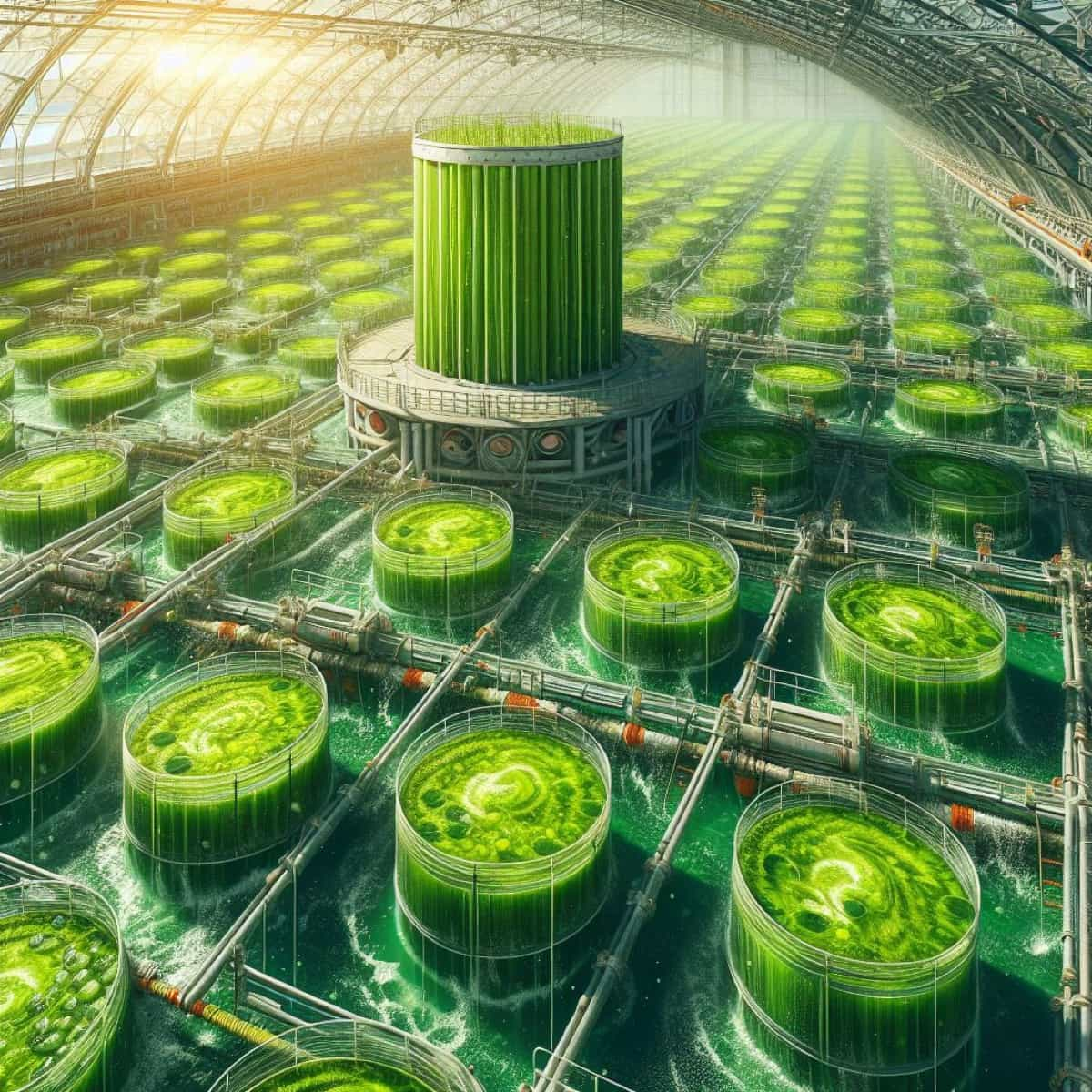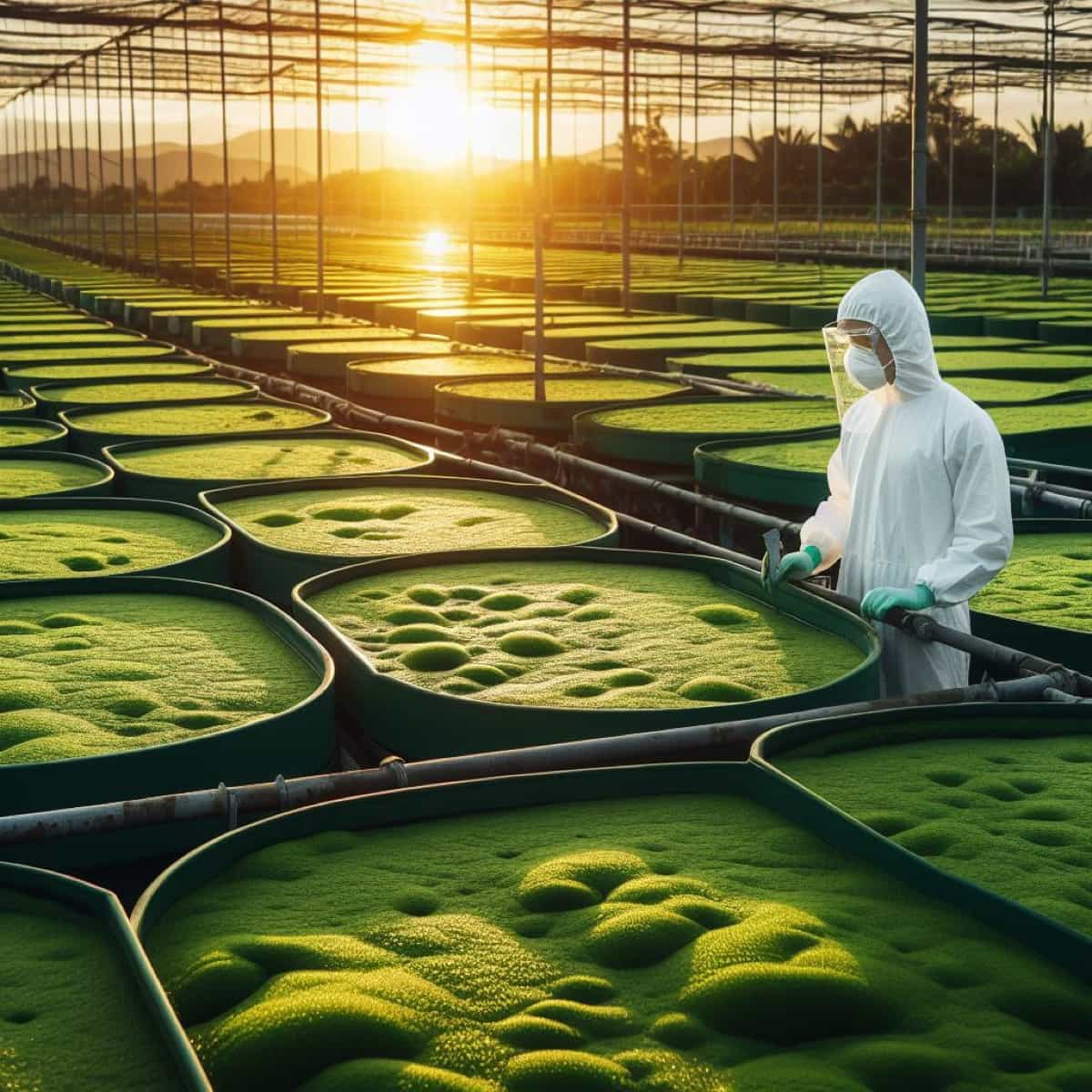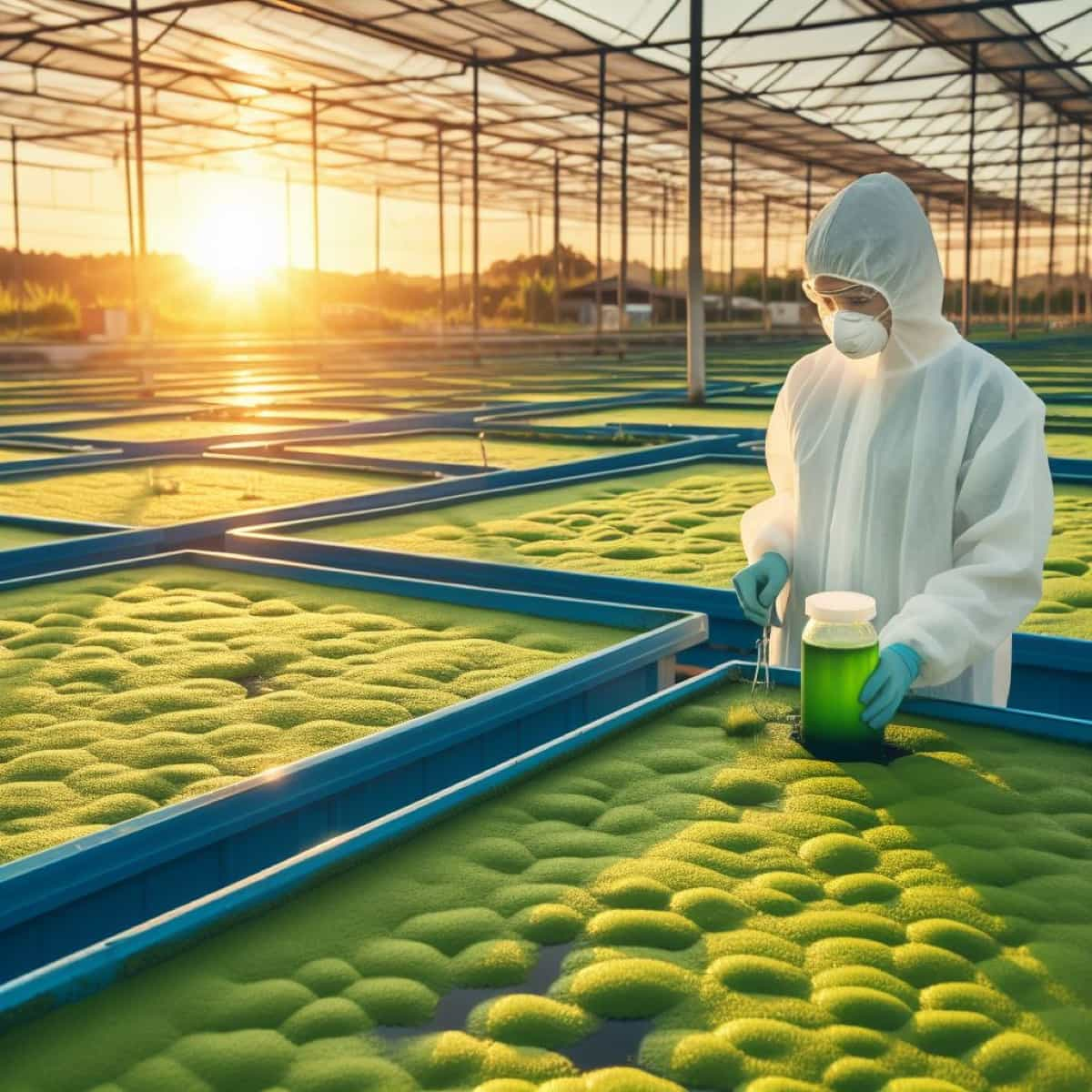Greenhouse Spirulina farming holds immense importance in today’s world. By utilizing a controlled environment within the greenhouse, farmers can create ideal growing conditions for Spirulina. This includes regulating temperature, humidity, and light intensity to ensure optimal growth and productivity. Additionally, greenhouse Spirulina farming offers opportunities for local communities by creating employment prospects and promoting economic development.

Greenhouse Spirulina Farming
Equipment and Materials Needed
You’ll need a greenhouse structure that can provide optimal conditions for growing Spirulina. This includes a sturdy frame, UV-resistant plastic coverings, and proper ventilation systems to control temperature and humidity levels. Next up is the cultivation tank or pond where the Spirulina will thrive. Additionally, you’ll need an efficient mixing system to ensure uniform distribution of nutrients in the water. Lighting is another critical component in greenhouse Spirulina farming.
Spirulina requires ample amounts of light for photosynthesis, so investing in high-quality LED grow lights or natural sunlight panels is essential. To monitor the nutrient levels and water quality in your cultivation system, you’ll need testing kits for pH levels, nitrogen compounds, phosphorus content, and trace elements like iron and magnesium. In terms of materials needed for culturing Spirulina strains, you’ll require freshwater sources free from contaminants such as chlorine or heavy metals.
Optimizing Environmental Conditions for Growing Greenhouse Spirulina
Creating the ideal environment is crucial for successful greenhouse Spirulina farming. By optimizing environmental conditions, you can ensure optimal growth and productivity of your Spirulina culture. Here are a few key factors to consider when fine-tuning your greenhouse setup for growing Spirulina. Temperature plays a vital role in Spirulina cultivation.
The optimum temperature range for growing Spirulina is between 28-35°C. Lighting is another critical aspect to address. Spirulina thrives under intense light, preferably natural sunlight or artificial lighting with similar wavelengths to sunlight. Providing around 12-16 hours of light per day helps maximize photosynthesis and enhance biomass production.
Proper ventilation is necessary to regulate humidity levels inside the greenhouse. Spirulina prefers low-humidity environments, ideally below 60%. Good air circulation helps prevent excessive moisture buildup and reduces the risk of contamination by unwanted microorganisms. Maintaining pH balance is imperative for cultivating healthy Spirulina cultures.
In case you missed it: Spirulina Cultivation Requirements: Exploring from Temperature to Water Quality Requirements

Starting the Spirulina Culture
To begin cultivating Spirulina in your greenhouse, you’ll need a few key ingredients: Spirulina starter culture, water, nutrients, and sunlight. The first step is to obtain a high-quality starter culture from a reputable source. This will ensure that your Spirulina colony starts strong and healthy.
Next, prepare the growth medium by dissolving the necessary nutrients in filtered or dechlorinated water. These nutrients typically include sodium bicarbonate for pH adjustment and various trace elements like iron, zinc, and copper. Make sure to follow the dosage provided by experts to maintain optimal conditions for growth.
Once your growth medium is prepared, add it to clean containers or tanks within your greenhouse. Ensure that these containers are thoroughly cleaned before use to prevent any contamination of the culture. It’s also important to maintain proper lighting conditions by placing them under full spectrum lights or near windows where they can receive the correct amount of sunlight.
After adding the growth medium, introduce the starter culture into each container and gently stir it in with a sterilized utensil. This will distribute the Spirulina cells evenly throughout the container. Allow time for your Spirulina colony to establish itself and grow. Regularly check on your Spirulina cultures for any signs of contamination or unusual behavior, such as changes in color or texture. If any issues arise, take immediate action by adjusting nutrient levels or addressing potential sources of contamination.
Nutrient Management in Greenhouse Spirulina
Spirulina, being a highly nutritious microalgae, requires specific nutrients to thrive and produce high-quality biomass. To achieve optimal growth and maximize yield, careful attention must be paid to nutrient levels in the cultivation system. The main aspect of nutrient management is maintaining the appropriate balance of macronutrients and micronutrients.
To ensure proper nutrient availability, it is necessary to regularly observe water quality parameters such as pH level and electrical conductivity (EC). These measurements help determine if any adjustments need to be made to maintain an ideal environment for Spirulina cultivation.
Additionally, organic carbon sources can be introduced into the culture medium to provide an additional source of energy for Spirulina’s growth. Common examples include molasses or plant extracts, which not only provide carbon but also contain trace elements that benefit the algae. Therefore, regular monitoring and adjustment of nutrient levels are vital for sustaining healthy growth.
In case you missed it: Spirulina Farming Systems: How to Grow Spirulina in Different Systems

Potential Challenges and Solutions
One potential challenge is maintaining the right temperature and humidity levels within the greenhouse. Spirulina thrives in warm temperatures, but too much heat can result in decreased productivity or even death of the culture. On the other hand, if temperatures drop too low, it can slow down growth or lead to contamination.
Another challenge is ensuring optimal nutrient levels in the water. Spirulina requires a balanced supply of nutrients such as nitrogen and phosphorous to grow properly. However, excessive nutrient levels can lead to algae blooms or imbalances that affect Spirulina growth. Contamination is also a concern when cultivating Spirulina in a closed environment like a greenhouse. It’s important to prevent the introduction of unwanted microorganisms that could harm the culture.
To address these challenges, careful monitoring and control systems are essential. Installing automated sensors for temperature and humidity regulation can help maintain ideal conditions for Spirulina growth. Regular testing of water quality parameters allows adjustments to be made to ensure proper nutrition levels without causing imbalances. Using sterile equipment during harvesting and processing prevents cross-contamination from outside sources.
Pest and Disease Management Strategies for Greenhouse Spirulina Farms
Regular cleaning of equipment, tanks, and surfaces helps prevent the buildup of algae or other potential sources of contamination. Additionally, implementing strict hygiene practices when working with the culture can greatly reduce the risk of introducing unwanted pests or diseases. Another effective strategy is using biological controls such as predatory insects or beneficial bacteria.
Regular monitoring and early detection are also essential in managing potential issues. Regularly inspect your crop for pests or disease signs and take immediate action if any problems arise. This may include manually removing infected cultures or applying targeted treatments if necessary. Additionally, practicing proper water quality management plays a significant role in preventing disease outbreaks.
Economic Viability of Greenhouse Spirulina Farming
Greenhouse farming provides the opportunity for higher yields compared to open pond systems. With careful monitoring and optimization of environmental conditions such as temperature, light intensity, and pH levels, farmers can maximize their crop output. Furthermore, the demand for Spirulina products has been increasing due to its nutritional value and health benefits. As consumer awareness regarding healthy eating habits continues to grow, there is a rising market demand for natural and sustainable superfoods like Spirulina.
Moreover, by implementing efficient water management systems such as recirculation or closed-loop systems within greenhouses, farmers can minimize water usage and reduce operational costs. This contributes to cost savings and also aligns with sustainable practices. Greenhouse Spirulina farming requires a relatively low initial investment compared to other agricultural ventures.
In case you missed it: Cost of Spirulina Cultivation in India: Exploring Equipment Costs to Quality Control

Harvesting and Maintaining the Spirulina
Spirulina should be harvested when it reaches its peak concentration, typically after 5-7 days of growth. This ensures that you’re maximizing your Spirulina yield while also maintaining the final product quality. Once it’s time for harvest, you’ll need to separate the Spirulina from the culture medium carefully. One common method is using a fine mesh or sieve to strain out any excess water.
The collected Spirulina can then be rinsed with clean water to remove any remaining impurities. After harvesting, proper maintenance is crucial for ensuring ongoing success with your Spirulina farm. This includes regular monitoring of pH levels, temperature, and nutrient concentrations in the culture medium.
Frequently Asked Questions (FAQ) on Greenhouse Spirulina Farming
How Does Greenhouse Spirulina Farming Work?
The process begins with obtaining high-quality Spirulina strains or cultures. These are then introduced into specially designed tanks or containers within the greenhouse environment. The tanks are filled with a carefully balanced mix of water and nutrients required for optimal growth.
Does Greenhouse Spirulina Farming Require Special Equipment?
Yes, setting up a greenhouse Spirulina farm requires specific equipment such as recirculating water systems, pumps for oxygenation, lighting fixtures to provide adequate illumination during low-light periods, and monitoring devices to track vital parameters like pH levels and temperature.
Is Greenhouse Spirulina Farming Profitable?
Yes. With increasing demand for health supplements and organic food products globally, there is a growing market for high-quality Spirulina. When properly managed, greenhouse Spirulina farms can be highly profitable ventures.
Conclusion
Spirulina thrives in warm climates and requires minimal water compared to traditional crops. With proper management techniques, farmers can achieve higher biomass production in a smaller area compared to open pond systems. By carefully monitoring and adjusting nutrient levels within the culture medium, farmers can maximize growth rates while maintaining nutritional quality.
- Feed Your Flock for Less: Top 10 Tips to Save on Chicken Feed
- Ultimate Guide to Ossabaw Island Hog: Breeding, Raising, Diet, and Care
- Hatching Answers: The Top 10 Reasons Your Chickens Aren’t Laying Eggs
- Eggs and Economics: Breaking Down the Cost of Raising Backyard Chickens
- Defend Your Greens: Proven Methods to Keep Iguanas Out of Your Garden
- Ultimate Guide to Cinnamon Queen Chicken: A Comprehensive Guide for Beginners
- Ultimate Guide to California Tan Chicken: Breeding, Raising, Diet, Egg-Production and Care
- Ultimate Guide to Marsh Daisy Chicken: Breeding, Raising, Diet, and Care
- 10 Types of Chicken Farming Businesses You Can Start for Profits